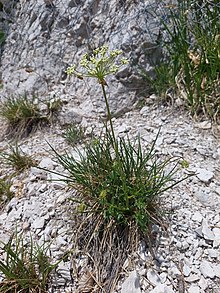| Hladnikia | |
|---|---|

| |
| Conservation status | |
 Data Deficient (IUCN 3.1) | |
| Scientific classification | |
| Kingdom: | Plantae |
| Clade: | Tracheophytes |
| Clade: | Angiosperms |
| Clade: | Eudicots |
| Clade: | Asterids |
| Order: | Apiales |
| Family: | Apiaceae |
| Genus: | Hladnikia Rchb. |
| Species: | H. pastinacifolia |
| Binomial name | |
| Hladnikia pastinacifolia Rchb. | |
| Synonyms | |
| |
Hladnikia is a monotypic genus of flowering plants belonging to the family Apiaceae. Its sole species, Hladnikia pastinacifolia, is a Slovenian paleoendemite, restricted to the area of only 4 km, located in Trnovo Forest Plateau, karst plateau of Western Slovenia. German botanist Heinrich Gottlieb Ludwig Reichenbach named the genus after Carniolan botanist and founder of Ljubljana Botanical Garden Franz Hladnik.
Description
Hladnikia pastinacifolia is a monocarpic herbaceous perennial plant, which takes a few vegetation periods to develop into a flowering plant. Individuals, which have erect flowering stem, can reach from 15 to 30 centimetres of height. At first plant's leathery and glossy leaves are simple shaped and arranged into rosettes. Later on, as their area increases, leaves also change shape into lobate. Hladnikia pastinacifolia resembles well-known celery (Apium graveolens), but has thicker foliage and shorter leaf stems. The species' root is long and lignified. The plant's flower has white, heart-shaped and 1 mm long petals.
Not much is known about the plant's exact breeding system. This plant species is entomophilous and has multiple different pollinators. It is thought that outcrossing happens occasionally. The species flowering period is between Mai and July. After successful pollination seeds that don't have any special dispersal adaptation develop between the end of August and into September. A fruit is a schizocarp, which after maturing splits into two 4 mm sized mericarps, 2 mm wide.
Hladnikia pastinacifolia chromosome number is 2n = 22.
Distribution and conservation
The plant is a Slovenian paleoendemic species restricted to small area (4 km) in Trnovski gozd. There these plants grow only on southern slopes of the plateau and two isolated areas located 9 km away on the northern slopes. As the plant species is not a habitat specialist its growing areas are various; Hladnikia pastinacifolia was found on stony grasslands, rock crevices and screes. Laboratory molecular analyses have shown that Hladnikia pastinacifolia is a Pleistocene survivor in situ.
Even though its population trend is labeled as stable by IUCN Red list, it has data deficient (DD) conservation status. Among mentioned threats are human intrusions and disturbance (such as recreational activities) as well as natural system modifications. The Trnovo Forest Plateau is listed as Natura 2000 site. Because of its small area of distribution and different threats the species is studied for possible cryopreservation.
References
- ^ Bilz, M. (2011). "Hladnikia pastinacifolia". IUCN Red List of Threatened Species. 2011: e.T162082A5530927.
- ^ "Hladnikia pastinacifolia Rchb". www.gbif.org. Retrieved 2021-08-15.
- "Hladnikia Rchb. | Plants of the World Online | Kew Science". Plants of the World Online. Retrieved 14 May 2021.
- ^ "Hladnikia pastinacifolia (rebrinčevolistna hladnikija)". www.botanicni-vrt.si (in Slovenian). Retrieved 2021-08-15.
- ^ Ciringer, Terezija (2016). Krioprezervacija rebrinčevolistne hladnikovke (Hladnikia pastinacifolia Rchb.) z optimizacijo inkapsulacijske dehidracije in vitrifikacije [Cryopreservation of Hladnikia pastinacifolia Rchb. with optimization of encapsulation dehydration and vitrification] (Thesis) (in Slovenian). OCLC 958133505. S2CID 125730341.
- ^ Šajna, Nina; Kavar, Tatjana; Šuštar-Vozliè, Jelka; Kaligariè, Mitja (1 January 2012). "Population Genetics of the Narrow Endemic Hladnikia Pastinacifolia RCHB. (Apiaceae) Indicates Survival in Situ During the Pleistocene". Acta Biologica Cracoviensia Series Botanica. 54 (1). doi:10.2478/v10182-012-0009-8.
- "Info in English | Botanično društvo Slovenije" (in Slovenian). Retrieved 2021-08-15.
- ^ Sajna, Nina; Šuštar-Vozlič, Jelka; Kaligarič, Mitja (28 October 2014). "New Insights into the Anatomy of an Endemic Hladnikia Pastinacifolia Rchb". Acta Botanica Croatica. 73 (2): 375–384. doi:10.2478/botcro-2014-0005. S2CID 36596271.
- ^ "Hladnikia pastinacifolia - Rchb". eunis.eea.europa.eu. Retrieved 2021-08-15.
- "ArcGIS Web Application". natura2000.eea.europa.eu. Retrieved 2021-08-15.
- Mujakić, Jakup (2016). Vpliv velikosti vcepka in gojišča na regeneracijo brstov rebrinčevolistne hladnikovke (Hladnikia pastinacifolia Rchb.) v tkivni kulturi [Influence of graft size and culture medium on regeneration of Hladnikia pastinacifolia Rchb. in tissue culture] (Thesis) (in Slovenian). OCLC 958134229.
- Ciringer, Terezija (2010). Mikropropagacija in krioprezervacija z inkapsulacijsko dehidracijo rebrinčevolistne hladnikovke (Hladnikia pastinacifolia Rchb.) : magistrsko delo [Micropropagation and cryopreservation with encapsulation dehydration of Hladnikia pastinacifolia Rchb] (Thesis) (in Slovenian). OCLC 781469120.
| Taxon identifiers | |
|---|---|
| Hladnikia | |
| Hladnikia pastinacifolia | |



